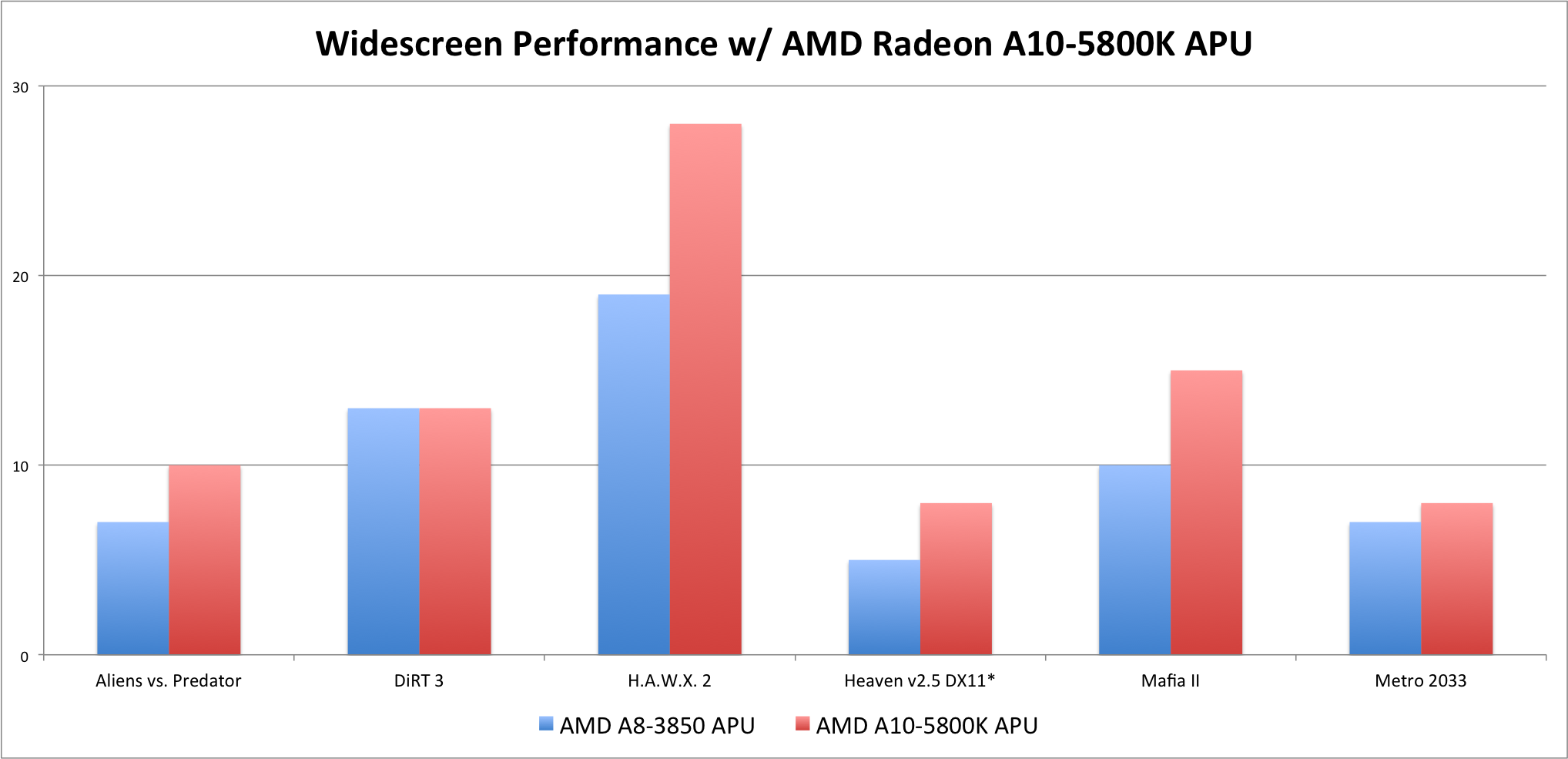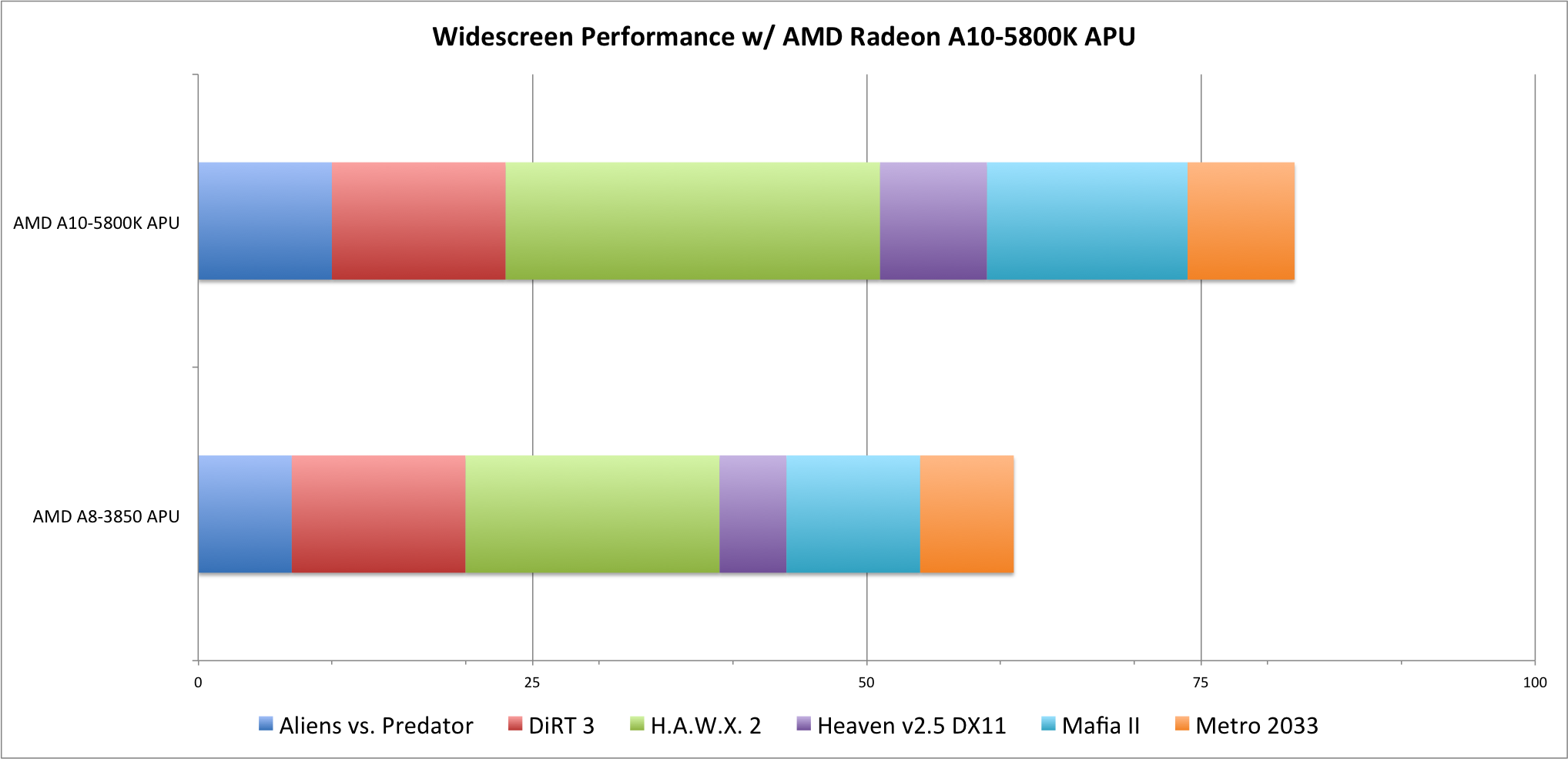AMD Trinity Preview - Gaming Performance
AMD has been prepping an update to its Fusion line of APUs. These chips offer both a CPU and discrete-class GPU functionality on one chip. The goal is to offer a better experience for machines built around "integrated graphics". AMD's APU line is targeted at Intel's Core-i3 line with HD4000 integrated graphics.
Also worth noting is that the A10 natively supports Eyefinity, and the MSI motherboard that AMD provided has DVI, HDMI and DisplayPort outputs. While I don't expect it to be able to perform in Eyefinity gaming, the A10 is designed to allow Eyefinity for normal computing and productivity tasks, and respectable gaming on a single 1080p Pricing is not yet available on the forthcoming releases, but AMD has provided us with a review sample and some press material.

Specifications
Last year we reviewed the flagship A8-3850 APU. It offered 4 processing cores, clocked at 2.9GHz. These processing cores were matched with a Radeon HD 6550D GPU, clocked at 600Hz. By contrast the upcoming A10-5800K offers 4 processing cores at 3.8GHz and a Radeon HD 7660D clocked at 800Hz.
| Platform | Series | Model | CPU | GPU | ||||
| Core | Freq. | Cache | Model | Config | Freq | |||
| Brazos | Zacate | E-350 | 1 | 1.5 GHz | 512KB | HD 6310D | 80:8:4 | 500MHz |
| Llano | Lynx | A8-3850 | 4 | 2.9 GHz | 4x 1MB | HD 6550D | 400:20:8 | 600MHz |
| Virgo | Trinity | A10-5800K | 4 | 3.8 GHz | 4x 1MB | HD 7660D | 384 | 800MHz |
Gaming Performance
Note: It's come to light that the RAM I pulled from my FX-8150 is underclocked for the A10-5800K. This is of particular impact, since the APU uses system RAM for VRAM. The performance using DDR3-1833 (versus the DDR3-1600 I used) is about 10% better.
Below are benchmark number from our normal "stress testing" suite. For our normal testing we run at max settings and 1080p in a single screen. The A10-5800K is a full 1/3 faster than the A8-3850 in our test suite. Even given this performance increase, most games are unplayable on the A10-5800K at max setting in Full HD. The one standout that offers playable performance is H.A.W.X. 2, which bumps right up against 30fps.


When looking at the performance is it crucial to remember that AMD is not targeting high-end gaming with the AMD APU line. The are targeting more casual gaming, or gaming at more moderate quality settings. For gaming at the highest performance settings, you need to look to the performance and enthusiast cards in AMD's discrete GPU line. That being said, the A10 is still a capable gaming platform if you go in with the proper expectations.
Hitting 30fps
I spent some time with each game in our test suite, and looked at what quality adjustments were required to hit 30 frames per second. In some games that simple wasn't possible; in others we were able to hit not only 30fps average, but also bring the minimum framerate above the magical 30fps.
Aliens vs. Predator
It is simply not possible to hit 30fps at 1080p, however we did get close to 30fps by dropping the resolution down to 1600x900. Even then we didn't hit that standard threshold for smooth gaming. You could lower the quality settings even more to get 30fps, but in my opinion the trade-off in quality isn't worth it. Hitting 26fps average is certainly better than the single digits offered at max settings, but AVP simply demands more horsepower than what the A10 can offer. My recommendation would be to explore other gaming titles available.
- Med/2xAA/8xAF: 12
- Med/0xAA/2xAF: 16
- Med/0xAA/2xAF/DX11 Off: 19
- 1600/Med/0xAA/2xAF/DX11 Off: 26
Dirt 3
Dirt 3 struggles with "Ultra" settings, but begins to shine with a few adjustments to the quality profile. Dropping to High will give you an average just above 30fps, but there is still some choppiness with the minimum frames clocking in at 26fps. Seeing that the average crossed 30fps with small changes, and that the minimum was close to 30fps, I did more testing to see if we could stay above 30 through the entire test.
Using the "High" quality profile, and turning off anti-aliasing, I was able to bring the minimum frames above 30fps. However, turning AA up to 2x only lost one frame and a minimum of 29fps is worth the improved image quality IMHO. Note: There is no "Very High," so "High" is only one notch down from "Ultra".
- 4xAA / High: 32/26
- 2xAA / High: 34/29
- 0xAA / High: 38/32
H.A.W.X. 2
At max settings, H.A.W.X. 2 almost hits 30fps. Turning anti-aliasing down from 4x to 2x brings the average framerate above 30fps. I tried some additional tweaks to see if I could push the fps higher, but was unable to get any tangible results. Adjusting each setting down one notch (either High > Medium, or High > Low) made no difference.
- 2xAA Max: 33
- 2xAA M/M/L/On/On/L/On/On: 33
Heaven 2.5 DX11
The Heaven Demo is known for being system-crushing. It's designed to stress high-end GPUs, and is by its nature too demanding for the A10-5800K. Dropping shaders to Medium, and setting tessellation to Moderate (along with 0xAA and 1xAF) allowed us to hit 13fps at 1080p. Dropping to 1600x900 lets us increase perofrmance to 18fps. Even moving to DX10 codepath only gives us two additional frames per second.
- Med/Mod/0x/1x: 13
- 1600/Med/Mod/0x/1x: 18
- 1600/DX10/Med/Mod/0x/1x: 20
Mafia II
Mafia II is a demanding title, and as we learned in our test of the NVIDIA GTX670, it is tuned for the GeForce line of GPUs. At max settings the A10 struggles. Dropping the overall settings to Medium (but retaining the 1080p resolution), and the game clocks in at 26fps. Turning off Ambient Occlusion get us close to our goal, with a result of 29fps. Dropping settings all the way to low brings us to 30fps.
- Medium: 26
- Medium -AOC: 29
- Low: 30
Metro 2033
Metro 2033 is also very demanding. Dropping to "High" settings, and reducing both AA and AF to their lower settings (you can't turn either off in the benchmark), only brings us to 16fps. Dropping the quality setting once more to Medium gets us a bit further to our goal at 22fps. Dropping the resolution to 1600x900 gets us there, but only at Low settings. You can get quite close at Medium settings, and the image improvements are certainly worth the 2fps difference.
- High/AAA/4xAF: 16
- Med/AAA/4xAF: 22
- 1600/Med/AAA/4x/AF: 28
- 1600/Low/AAA/4x/AF: 30
Initial Thoughts & Next Steps
The A10-5800K is certainly a step up from the A8-3850. It offers significantly improved performance in our stress test, and offers solid mainstream gaming performance. Getting above 30fps (with only minimal reductions in image quality) in both Dirt 3 and HAWX 2 is a great feat for the A10-5800K using the integrated GPU.
In my reviews of the E-350 and A8-3850 APUs I looked at game performance in a few additional titles. With even the E-350, I found the performance in titles such as Orcs Must Die!, Torchlight and Guild Wars to be perfectly playable. The A8-3850 easily bested the E-350, and I'm going to look at those same titles here.
Additionally I'm going to look at the sequels to these titles (fitting since I'm testing the sequel to the A8-3850) and other newer mainstream releases such as Jet Set Radio HD. I will also be doing some gaming-oriented testing of the processing cores (by running the chip through our gaming test suite with a Radeon HD 7970 GHz Ed). This will let me test its CPU performance (and value proposition) against the Intel Core i7-2600k and the AMD FX-8150. All that will be included in the final review, once pricing and availability are announced.
